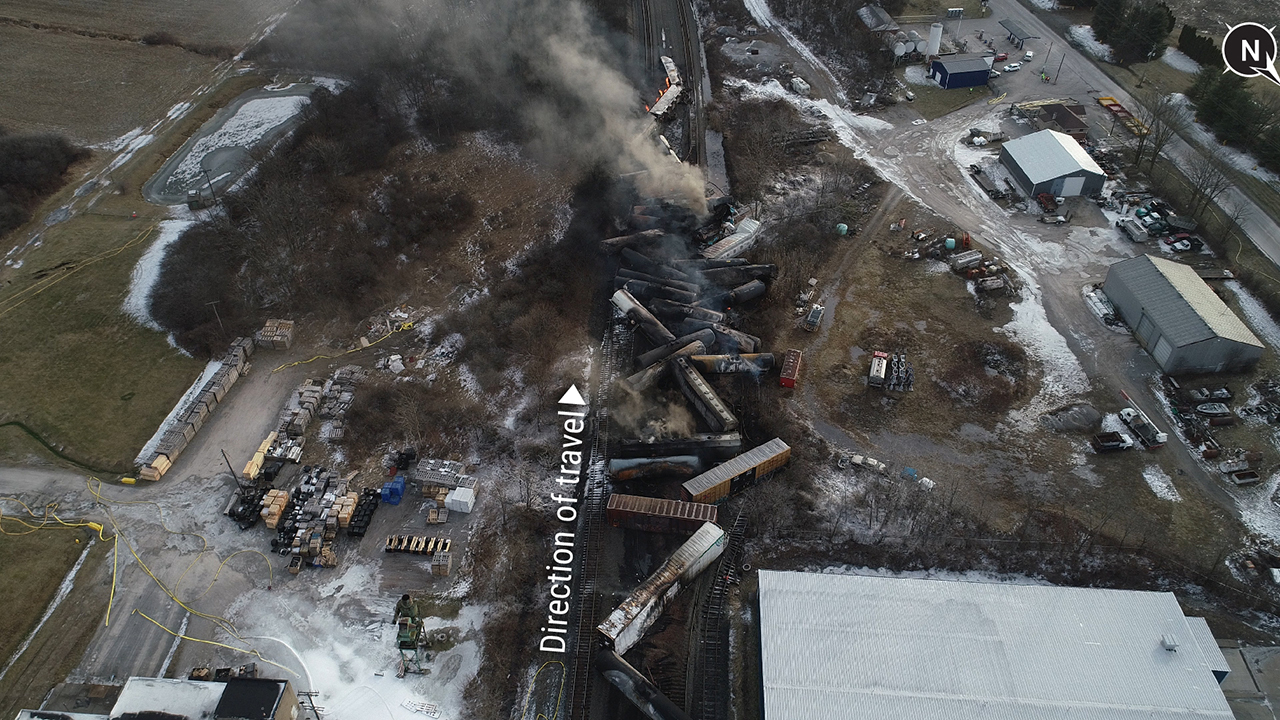
FRA Releases Supplemental Advisory Related to Hot Bearing Wayside Detectors
Written by Carolina Worrell, Senior Editor
NTSB photo
The Federal Railroad Administration (FRA) on June 9 announced that it has made an additional recommendation to Safety Advisory 2023-01, originally published on March 3, addressing the use and maintenance of hot bearing detectors (HBDs) in response to the May 10 Norfolk Southern (NS) derailment in New Castle, Penn., which was suspected of being the result of a burnt journal bearing.
According to FRA, preliminary information related to this most recent accident shows that the train involved passed a HBD which alarmed prior to the accident.
Accordingly, FRA has issued this supplemental notice (download below), which adds a fifth recommendation to Safety Advisory 2023-01; Evaluation of Policies and Procedures Related to the Use and Maintenance of Hot Bearing Wayside Detectors, recommending that railroads “take action to evaluate the resiliency and accuracy of the overall process used to monitor and measure bearing health.”
As originally published, FRA says Safety Advisory 2023-01 “did not address the effectiveness of railroads’ established processes and procedures in ensuring adequate and accurate bearing health data is gathered from detectors, analyzed, and communicated to all railroad personnel responsible for making decisions or taking action in response to that data.”
FRA notes that “the process of gathering, monitoring, reporting, analyzing, and actioning information from detectors includes tasks that, if incorrectly done, can introduce risk.” For instance, according to the supplemental advisory, “an error in HBD installation or maintenance that is not identified by commissioning testing, may impact the reporting of HBD measurements. Similarly, processes with insufficient redundancies or crosschecks to ensure each necessary step or task is performed timely and accurately may lead to failures in the processes that allow a valid detector alert or alarm to go undetected.”
Accordingly, in addition to the four recommendations contained in Safety Advisory 2023-01 as originally published, with this supplementary notice, FRA is making a fifth recommendation to railroads. Specifically, FRA recommends that railroads “evaluate each step and task performed by railroad personnel to identify any potential points where non-revealing failures may occur (i.e., any steps or tasks that, if not performed or performed incorrectly or timely, could mislead decision makers when actioning a HBD report or lack of a HBD report).” FRA also recommends that railroads “implement appropriate safeguards to minimize the impact of any non-revealing failures when monitoring, analyzing, and responding to detector information.”
Considering the above, FRA’s five recommendations in Safety Advisory 2023-01 now include the following:
- “Review existing HBD system inspection and maintenance policies and procedures for compliance with existing industry standards and manufacturer recommendations for HBDs.
- “Review existing procedures to train and qualify personnel responsible for installing, inspecting, and maintaining HBDs to ensure they have the appropriate knowledge and skills. Railroads should also develop and implement appropriate training on the inspection and maintenance requirements for HBDs and provide that training at appropriate intervals to ensure the required knowledge and skill of inspection and maintenance personnel. Further, railroads should evaluate their training content and training frequency to ensure any employee who may be called upon to evaluate a suspect bearing has the necessary training, experience, and qualifications. FRA also encourages railroads to ensure these individuals are available at all hours of operations across a railroad’s network.
- “Review current HBD detector thresholds in light of recent derailments, and all other relevant available data (including data from any close calls or near misses), to determine the adequacy of the railroad’s current thresholds. Thresholds should be established for single measurement as well as multiple measurements of individual bearings to enable temperature trend analysis.
- “Review current procedures governing actions responding to HBD alerts to ensure required actions are commensurate with the risk of the operation involved. With regard to trains transporting any quantity of hazardous materials, FRA recommends railroads adopt the procedures outlined in AAR’s OT-55 for key trains as an initial measure.
- “Rigorously evaluate the resiliency and accuracy of the overall process used to monitor and act upon information from wayside detectors, with specific focus on steps and tasks that, if not performed or performed incorrectly, could mislead decision makers. The process of monitoring, reporting, inspecting, analyzing, and acting on information from detectors includes tasks that, if incorrectly executed, could introduce risk. Railroads should also evaluate each step and task performed by railroad personnel to pinpoint any HBD reporting failures and implement appropriate safeguards to minimize the impact of those failures when monitoring, analyzing, and responding to detector information.”
FRA says it “encourages railroads to continue to take actions consistent with Safety Advisory 2023-01 as originally published and the additional recommendation in this supplementary notice, as well as any other complementary actions, to ensure the safety of rail transportation.” FRA may modify this Safety Advisory and supplementary notice, issue additional safety advisories, or take other actions necessary to “ensure the highest level of safety on the Nation’s railroads, including pursuing other corrective measures under its authority,” according to the supplemental notice.



